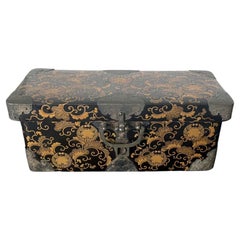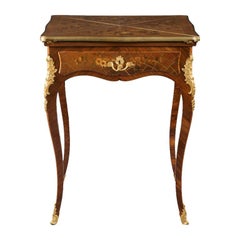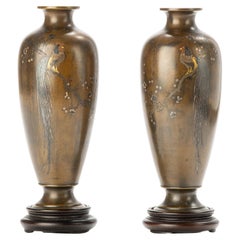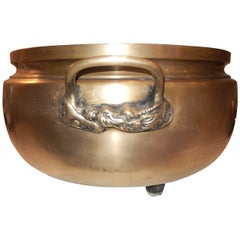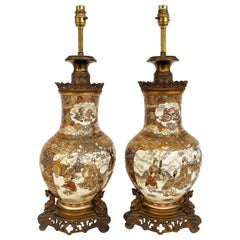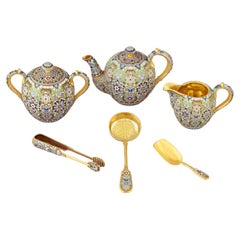Japonisme Furniture
In the late 19th and early 20th century, France developed an enduring passion for Japanese aesthetics and craftsmanship. Not only did this interpretation of Japanese culture — which became known as Japonisme — infuse fresh energy into French art and design, but it also radically transformed how Europeans, and subsequently the world, would come to understand visual culture.
Until 1853, Japan had been closely guarded against foreign visitors for over two centuries. However, American Commodore Matthew C. Perry sailed into Japan that year and initiated the first of its treaties with the United States and Europe, thereby opening its borders and giving the West its first-ever look at Japanese design.
For the next few decades, taken with Japonisme, sophisticated collectors in Paris, New York and elsewhere gorged themselves on lacquered screens, celadon ceramics and netsuke ornaments, along with artworks depicting various aspects of Japanese life. The East Asian country’s influence on Europe, particularly France, contributed to one of the most creatively prosperous periods in history, leaving an imprint on the Impressionist, Art Nouveau and Art Deco movements, and inspiring artists like Edgar Degas, Mary Cassatt, Vincent van Gogh as well as luxury houses such as Louis Vuitton and Hermès. Japonisme emerged at the time when the ornate Renaissance Revival style was the most prominent mode of decorating in Europe, and Japanese aesthetics seemed strikingly modern and elegant in comparison.
In addition to everyday practical objects from Japan, such as vases, tableware and decorative boxes, Japanese art, especially Japanese woodblock prints by masters of the ukiyo-e school, caught the eye of many artists — particularly those in the Art Nouveau poster community in 1880s Paris. The luscious organic colors associated with traditional Japanese design, motifs like cherry blossoms and carp and the vivid patterns found in woodblock prints, silks and more were adopted and appropriated by painters as well as ceramicists and those working in other fields of the decorative arts. Today, demand for Japanese lacquerware — furniture, trays, writing boxes, screens, incense burners — from the Edo period (1615–1868) and the late 19th century continues to be very strong among collectors.
Find a collection of antique Japonisme furniture and decorative objects on 1stDibs.
Early 19th Century Japanese Antique Japonisme Furniture
Copper
Late 19th Century French Antique Japonisme Furniture
Bronze, Brass
Late 19th Century Japanese Antique Japonisme Furniture
Bronze
1890s Japanese Antique Japonisme Furniture
Bronze
19th Century Japanese Antique Japonisme Furniture
Bronze
19th Century Russian Antique Japonisme Furniture
Silver, Enamel
Late 19th Century Japanese Antique Japonisme Furniture
Bronze
19th Century French Antique Japonisme Furniture
Enamel, Ormolu
Late 19th Century French Antique Japonisme Furniture
Brass, Ormolu
Late 19th Century Japanese Antique Japonisme Furniture
Bronze
Late 19th Century French Antique Japonisme Furniture
Ceramic
1970s Japanese Vintage Japonisme Furniture
Silk, Canvas
Late 19th Century Japanese Antique Japonisme Furniture
Stone
1960s Japanese Vintage Japonisme Furniture
Rattan
1920s Japanese Vintage Japonisme Furniture
Silver Leaf
20th Century Japanese Japonisme Furniture
Bronze
Mid-20th Century English Japonisme Furniture
Porcelain
1890s French Antique Japonisme Furniture
Bronze
20th Century Japanese Japonisme Furniture
Ceramic, Lacquer
Mid-20th Century Japanese Japonisme Furniture
Silk, Linen
1930s Japanese Vintage Japonisme Furniture
Bamboo
19th Century Japanese Antique Japonisme Furniture
Wood, Lacquer
Late 19th Century French Antique Japonisme Furniture
Bronze
Early 1900s English Antique Japonisme Furniture
Ceramic
1980s Japanese Vintage Japonisme Furniture
Porcelain
1880s English Antique Japonisme Furniture
Porcelain
1980s Vintage Japonisme Furniture
Ceramic
Early 20th Century French Japonisme Furniture
Bronze
Late 19th Century Japanese Antique Japonisme Furniture
Bronze
1850s English Antique Japonisme Furniture
19th Century Japanese Antique Japonisme Furniture
Wood, Lacquer
Late 19th Century French Antique Japonisme Furniture
Faience
19th Century Japanese Antique Japonisme Furniture
Wood, Lacquer
19th Century Japanese Antique Japonisme Furniture
Ceramic
Early 20th Century Japanese Japonisme Furniture
Brocade, Silk
1840s English Antique Japonisme Furniture
Ironstone
1880s French Antique Japonisme Furniture
Enamel, Bronze
Early 20th Century Japanese Japonisme Furniture
Copper
Early 20th Century Japanese Japonisme Furniture
Metal, Enamel
19th Century Japanese Antique Japonisme Furniture
Silk, Plaster
1880s French Antique Japonisme Furniture
Mother-of-Pearl, Wood
1880s American Antique Japonisme Furniture
Sterling Silver, Copper
1890s Japanese Antique Japonisme Furniture
Lacquer
1870s American Antique Japonisme Furniture
Silver, Sterling Silver
1960s Japanese Vintage Japonisme Furniture
Gold Leaf
1880s French Antique Japonisme Furniture
Crystal, Bronze
Late 19th Century Japanese Antique Japonisme Furniture
Ceramic
Early 1900s French Antique Japonisme Furniture
Silver
Early 1900s Japanese Antique Japonisme Furniture
Bamboo, Lacquer
Late 19th Century Japanese Antique Japonisme Furniture
Porcelain
19th Century French Antique Japonisme Furniture
Bronze
1880s French Antique Japonisme Furniture
Fabric, Mirror, Wood, Lacquer
Late 19th Century Japanese Antique Japonisme Furniture
Ceramic
20th Century Japanese Japonisme Furniture
Bamboo, Rattan
19th Century Japanese Antique Japonisme Furniture
Bronze
1960s Japanese Vintage Japonisme Furniture
Porcelain
Early 19th Century Japanese Antique Japonisme Furniture
Brocade, Silk
1970s Japanese Vintage Japonisme Furniture
Ceramic
1920s Japanese Vintage Japonisme Furniture
Ceramic
19th Century Japanese Antique Japonisme Furniture
Boxwood
